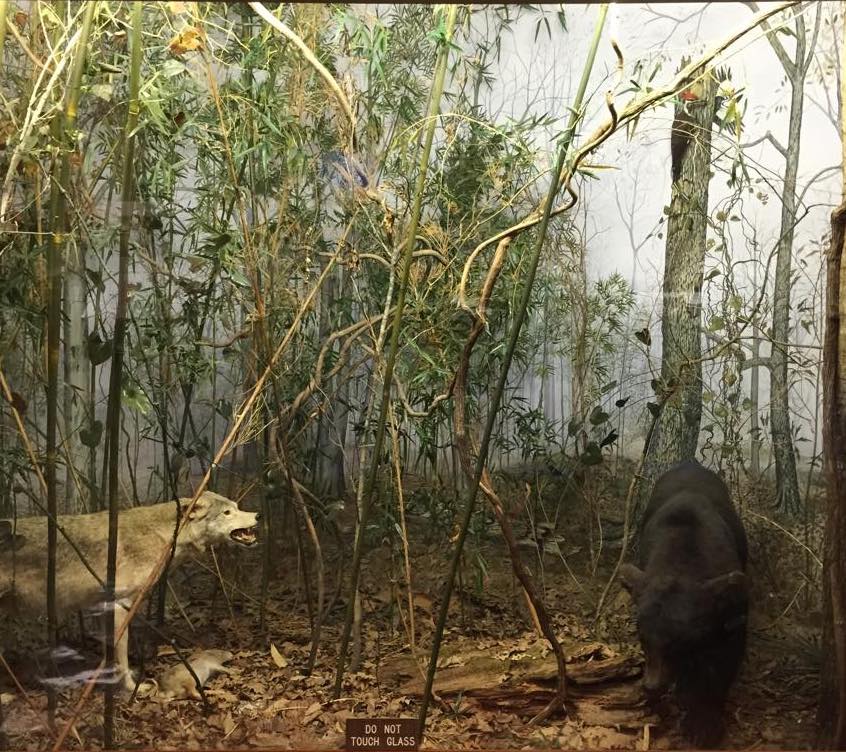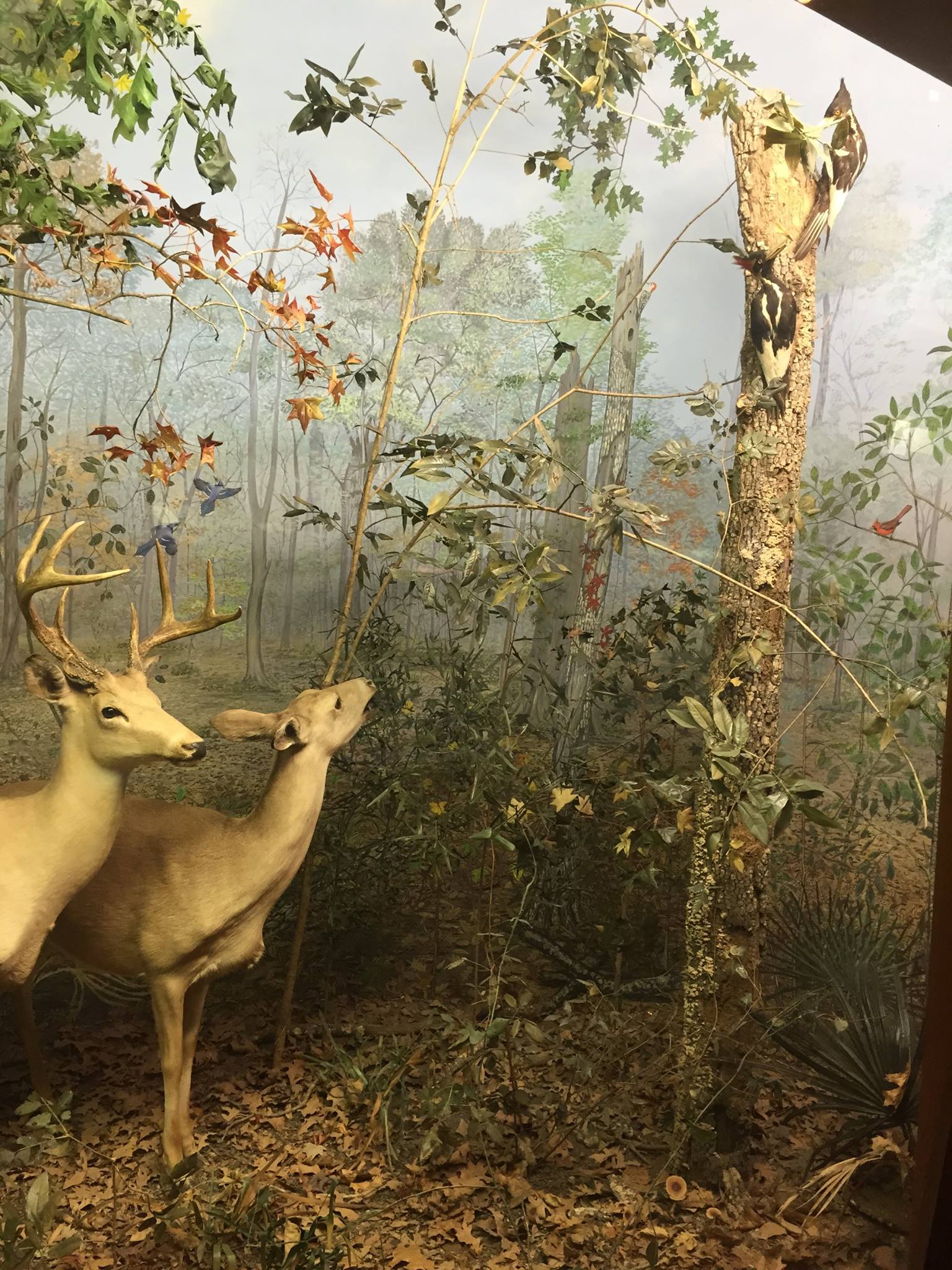Louisiana's Past
The Border of a Canebrake

This diorama recreates a canebrake near Tallulah, Louisiana. Canebrakes were vast stands of cane (American Bamboo) that once covered large areas throughout the South from the Carolinas to eastern Texas. To try and get an idea of how thick these gigantic grass stands were, imagine that you have shrunk to the size of an ant and have to travel through the thick grass of your lawn! These canebrakes grew thickest near river bottoms and thinned out as they reached higher ground, becoming understory beneath forest canopies. In the wide river valleys, these canebrakes grew extremely thick and their stands stood up to forty feet high. They were so thick that the interlacing leaves above blocked much of the sun and people traveling through these areas made little progress! These areas disappeared, however, in the early 1800s because the fertile floodplains they grew on were cleared for agriculture purposes. Flood-control also contributed to their decline by eliminating the seasonal flooding the bamboo needed to thrive. Today there are only remnants of these areas in remote areas of the state. The large predators depicted in this habitat, the red wolf and black bear, still roam Louisiana’s wilderness areas, though in diminishing numbers. The Passenger Pigeon and Carolina Parakeet, however, both became extinct as a result of the loss of this habitat and of overhunting. The loss of these areas has also resulted in the near loss of the Bachman’s Warbler, which may have needed these areas as nesting grounds.
Short Facts
- Canebrakes were stands of thick grasses that stood up to 40 feet tall
- Canebrakes disappeared in the early 1800s, because they were cleared for agricultural purposes
- Remnants of canebrakes can be found in remote areas of Louisiana, along with Black Bears and, possibly, Red Wolves
Teacher's Corner
Ask your children or students questions such as:
- How is the canebrake area different from a forest?
- Can you find the Carolina Parakeet?
- Why is it so hard to see and how might that have been helpful to it?
The Louisiana Prairie Long Ago

When one hears the word prairie, a vision of the great plains, with wide-open spaces covered in grass comes to mind. It may come as a surprise, however, that once this type of habitat dominated by grasses could be found in large areas of the U.S., including right here in Louisiana! Calcasieu, Jefferson Davis, Allen, Evangeline, Acadia, and several other parishes supported the prairie habitat in our state. A layer of clay beneath the surface of the soil in southwestern Louisiana prevented tree roots from penetrating and taking hold, therefore, the region remained a grassland for thousands of years. Unfortunately, grazing and rice farming began to claim these areas. Many animals (including buffalo) depending on these areas for their survival, suffered from these changes in habitat and eventually declined. The prairie vole, the Greater Prairie Chickens, and the wild Whooping Crane in this display were once abundant in Louisiana. Whooping Cranes used to breed and nest from Canada all the way to Louisiana. They stood close to five feet tall, with beautiful white plumage. They were often killed for feeding on grains in farmers’ fields, or by hunters who did not realize they were endangered. As the Whooping Crane population became close to extinction, biologists had to intervene to save them. By 1954 there were only 25 of these birds left. Today the population is growing, but there are still only about 100 – a number that one major natural disaster could wipe out. The five-foot specimen in this display case was donated to the Museum by the U.S. National Museum of Natural History. Attwater’s Greater Prairie Chicken has survived because of a few wildlife refuges that maintain small patches of grasslands. These birds have unique mating rituals that involve the males gathering to perform strange dances and emitting calls that can be heard up to two miles away! Today, Louisiana’s prairie land remains open and unforested, but grazing and rice cultures have radically changed its appearance. Many of its original inhabitants have vanished, never to return.
Short Facts
- The last of the five-foot-tall Louisiana Whooping Cranes died in 1950
- The animals in this scene live in prairie or grassland habitats, which have been replaced with grazing and rice farming habitats in Louisiana.
Teacher's Corner
Ask your children or students questions such as:
- Why is it important for us to know which plant and animal species are endangered?
- If you were in charge of protecting an endangered species, how would you do it?
In a Virgin Bottomland Forest

The great American hardwood forest stretched across one-third of the continent before the age of the lumber industry. These forests were characterized by large mature trees that dominated the vegetation. Like the rainforest, the vegetation in these areas was very dense and restricted light from getting to the forest floor, so there was little understory. Many of the trees of these areas were extremely old. In fact, LSU was once covered by a forest just like the one you see before you! Sizable remnants of virgin forest persisted in Madison Parish until 1943, but these are now gone. What remains is called a secondary forest, where mature trees are the exception, rather than the rule. The White-tailed Deer was an inhabitant of these areas and still remains in woodlands across our state. The Ivory-billed Woodpecker, once common in our State, did not survive the destruction of these areas. This woodpecker required old, dying trees to survive because this is where it found its favorite food, beetle larvae. In the 1940s, Louisiana’s last virgin bottomland forests were cut in Madison Parish, and this bird disappeared. The birds in this display were collected in Franklin, Louisiana, in 1899.
Short Facts
- The Ivory-billed Woodpecker ate beetle larvae, which they found in old, dying trees.
- The great American hardwood forest stretched across one-third of the continent before the invention of the ax and saw.
- In the distant past, many of these animals could be seen right here on the LSU campus.
Teacher's Corner
Ask your children or students questions such as:
- Why did the Ivory-billed woodpecker die out when the forests were cut?
- Couldn’t it just find something else to eat?
- Talk about being adapted to a specific way of life and how that can be unhelpful sometimes when the environment changes.
- Why did the deer survive, but the woodpecker die?